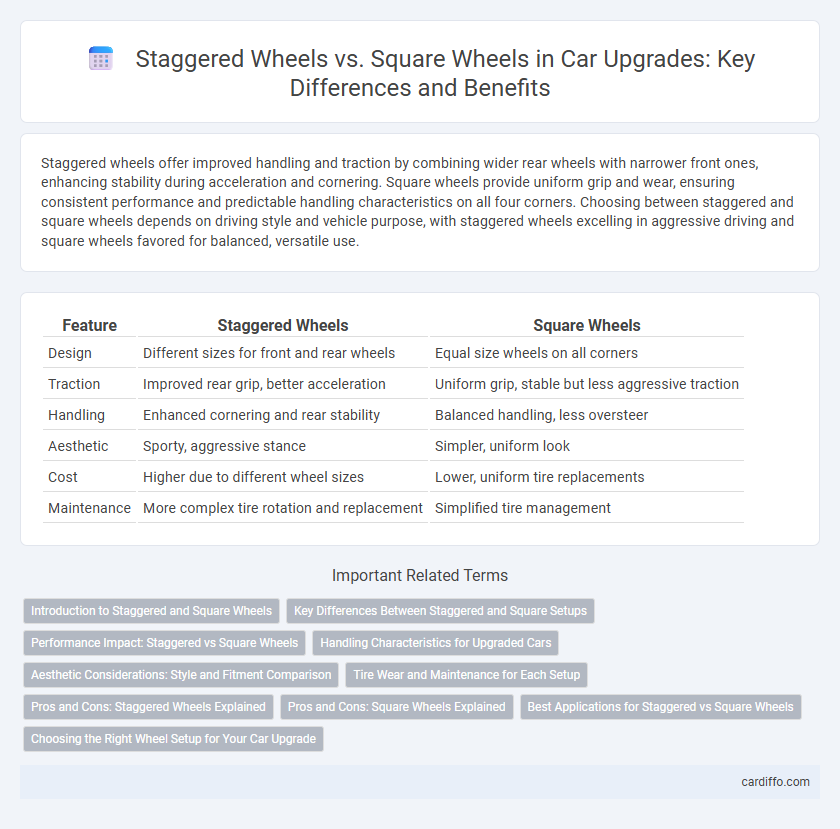Staggered wheels offer improved handling and traction by combining wider rear wheels with narrower front ones, enhancing stability during acceleration and cornering. Square wheels provide uniform grip and wear, ensuring consistent performance and predictable handling characteristics on all four corners. Choosing between staggered and square wheels depends on driving style and vehicle purpose, with staggered wheels excelling in aggressive driving and square wheels favored for balanced, versatile use.
Table of Comparison
| Feature | Staggered Wheels | Square Wheels |
|---|---|---|
| Design | Different sizes for front and rear wheels | Equal size wheels on all corners |
| Traction | Improved rear grip, better acceleration | Uniform grip, stable but less aggressive traction |
| Handling | Enhanced cornering and rear stability | Balanced handling, less oversteer |
| Aesthetic | Sporty, aggressive stance | Simpler, uniform look |
| Cost | Higher due to different wheel sizes | Lower, uniform tire replacements |
| Maintenance | More complex tire rotation and replacement | Simplified tire management |
Introduction to Staggered and Square Wheels
Staggered wheels feature different sizes on the front and rear axles, enhancing performance and aesthetics by improving traction and handling dynamics. Square wheels maintain the same diameter and width on all four corners, offering uniform tire wear and easier rotation while preserving balance. Choosing between staggered and square wheels depends on driving style, vehicle type, and desired handling characteristics.
Key Differences Between Staggered and Square Setups
Staggered wheel setups feature different sizes on the front and rear axles, typically wider wheels in the rear for enhanced traction and aggressive aesthetics, while square setups use the same size wheels on all corners, promoting balanced handling and easier tire rotation. Staggered setups optimize rear-wheel grip for performance driving but limit tire rotation options, whereas square setups offer uniform tire wear and improved stability in variable driving conditions. The choice between staggered and square wheels depends on driving priorities, with staggered favoring sporty dynamics and square focusing on versatility and maintenance efficiency.
Performance Impact: Staggered vs Square Wheels
Staggered wheels improve cornering grip and handling by fitting wider tires on the rear axle, providing better traction and stability during high-speed maneuvers. Square wheels offer balanced performance with equal-sized tires on all four corners, enhancing tire rotation options and extending tread life while maintaining predictable driving dynamics. The performance impact depends on driving style and conditions, with staggered setups favoring aggressive handling and square wheels supporting versatility and tire longevity.
Handling Characteristics for Upgraded Cars
Staggered wheels enhance handling characteristics by providing wider rear tires that improve traction and stability during cornering, essential for upgraded cars with increased power output. In contrast, square wheels, with equal width on all corners, offer more balanced handling but may sacrifice rear grip under aggressive acceleration. Choosing staggered wheels optimizes rear-end grip and reduces oversteer, making them ideal for performance-focused upgrades where improved handling precision is critical.
Aesthetic Considerations: Style and Fitment Comparison
Staggered wheels offer a dynamic and aggressive aesthetic, emphasizing a wider rear tire for enhanced road presence and a sportier stance, while square wheels provide a balanced, uniform look that complements vehicles seeking a symmetrical fitment. The style of staggered setups often appeals to performance enthusiasts aiming for visual distinction, whereas square wheels align with practical styling and even tire wear. Fitment-wise, staggered wheels require precise calibration to avoid handling issues, whereas square wheels simplify alignment and rotation, maintaining consistent aesthetics.
Tire Wear and Maintenance for Each Setup
Staggered wheels typically cause uneven tire wear due to differences in tire sizes between the front and rear, leading to more frequent maintenance and potential alignment issues. Square wheels, with equal-sized tires on all corners, promote even tire wear, simplifying rotation schedules and extending tire lifespan. Maintenance costs are generally lower for square setups because they reduce the need for specialized tires and minimize irregular tread wear.
Pros and Cons: Staggered Wheels Explained
Staggered wheels offer enhanced traction and improved handling by fitting wider tires on the rear axle, which benefits high-performance vehicles during acceleration and cornering. However, they can increase maintenance costs and limit tire rotation options, potentially leading to uneven tire wear. Square wheels provide more balanced wear and simplified maintenance but may sacrifice some rear traction and aggressive handling characteristics.
Pros and Cons: Square Wheels Explained
Square wheels provide excellent traction on flat surfaces due to their consistent edge contact but cause a bumpy ride and increased rolling resistance, reducing overall efficiency. Staggered wheels, with their alternating sizes, enhance stability and handling on uneven terrain, offering smoother performance and better weight distribution. Choosing between square and staggered wheels depends on the specific application, balancing the trade-off between traction benefits and ride comfort.
Best Applications for Staggered vs Square Wheels
Staggered wheels offer enhanced traction and improved handling for high-performance vehicles, making them ideal for sports cars and track-focused applications due to their optimized front and rear tire sizes. Square wheels provide balanced grip and easier rotation, benefiting daily drivers and off-road vehicles that require uniform wear and consistent performance. Choosing between staggered and square wheels depends on prioritizing either specialized handling advantages or maintainability and tire longevity.
Choosing the Right Wheel Setup for Your Car Upgrade
Choosing the right wheel setup for your car upgrade depends on performance goals and handling preferences. Staggered wheels, featuring wider rear tires than front, enhance traction and stability during acceleration, making them ideal for rear-wheel-drive vehicles seeking improved cornering and grip. Square wheels, with equal tire sizes on all four corners, promote balanced handling and even tire wear, suitable for drivers aiming for consistent performance and easy rotation maintenance.
Staggered wheels vs square wheels Infographic

 cardiffo.com
cardiffo.com